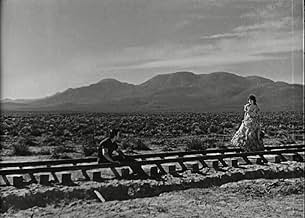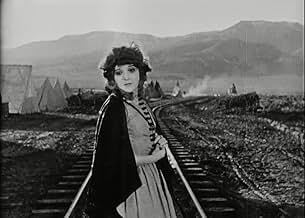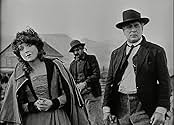IMDb रेटिंग
7.2/10
2.5 हज़ार
आपकी रेटिंग
अपनी भाषा में प्लॉट जोड़ेंAfter witnessing the murder of his father by a renegade as a boy, the grown-up Brandon helps to realize his father's dream of a transcontinental railway.After witnessing the murder of his father by a renegade as a boy, the grown-up Brandon helps to realize his father's dream of a transcontinental railway.After witnessing the murder of his father by a renegade as a boy, the grown-up Brandon helps to realize his father's dream of a transcontinental railway.
- पुरस्कार
- कुल 2 जीत
J. Farrell MacDonald
- Cpl. Casey
- (as J. Farrell Macdonald)
Jim Welch
- Pvt. Schultz
- (as James Welch)
- …
George Waggner
- Buffalo Bill Cody
- (as George Wagner)
James A. Marcus
- Judge Haller
- (as James Marcus)
Chief John Big Tree
- Cheyenne Chief
- (बिना क्रेडिट के)
Chris Willow Bird
- Indian
- (बिना क्रेडिट के)
Danny Borzage
- Worker
- (बिना क्रेडिट के)
George Brent
- Worker
- (बिना क्रेडिट के)
Milton Brown
- Minor Role
- (बिना क्रेडिट के)
Thomas Carr
- Rail Worker
- (बिना क्रेडिट के)
कहानी
क्या आपको पता है
- ट्रिवियाThe kitchen staff for the film was made up largely of Chinese cooks. Some of them had been workers on the transcontinental railroad in 1869, the same construction project that forms the basis of this film.
- गूफ़The locomotives and rolling stock are using knuckle-type couplers which did not begin wide use until the 1890's. In the 1860's era setting of this movie, the couplers in use would have been link and pin. This anachronism is understandable as the safety issue would have prohibited the use of the era appropriate link and pin couplers.
- भाव
Thomas Marsh: [after he older Brandon has verbalized his dream of a trancontinental railroad] Poor dreamer - he's chasing a rainbow.
Lincoln: Yes, Tom - and some day men like you will be laying rails along that rainbow.
- इसके अलावा अन्य वर्जनThe DVD release of this film contains two different edits, one for the American market and one for Europe. The American release is 16 minutes longer than the European cut. The American cut is dedicated to the memory of Abraham Lincoln while the European release is dedicated to the memory of George Stephenson. In the American release Fred Kohler's character is named Deroux while in the European cut his character is named Bauman.
- कनेक्शनEdited into The Story of Our Flag (1939)
- साउंडट्रैकBlow the Man Down
(uncredited)
Traditional 19th Century Sea Chanty (1860s)
[Integrated into restoration score into divorce and going back to work scenes]
फीचर्ड रिव्यू
A young boy grows to fulfill his murdered father's vision of seeing THE IRON HORSE, the mighty transcontinental railway, stitch the country together, binding East to West.
Bursting with excitement & patriotic fervor, THE IRON HORSE is the film which put young director John Ford on the cinematic map. He brought together all he had learned from years of making shorter, smaller films and he produced a product which heralded his enormous contributions to sound films in the years to come. This is a `director's picture' in that the stars, as good as they are, are almost negligible; what was important here was Ford's vision & his ability to place it before the audience. Indeed, he does not even bring his leading man (George O'Brien) on screen until 45 minutes into the story - a shortcut to disaster almost anywhere else.
(In all fairness it should be noted that O'Brien, handsome & strong-limbed, does very well as the gentle hero. He would find similar roles in other epic films of the decade. J. Farrell MacDonald, as Irish Corporal Casey, is the prototype for many comically eccentric fellows who would appear in other Ford westerns.)
The film often takes on the aspects of an ancient newsreel. Cattle drives, Indian attacks & endless track laying all look utterly real. Particularly fascinating is the depiction of the dismantlement of the end-of-the-track town, so that not even a dog is left, as it is moved many miles further on to the west. This type of arcane information is what makes watching very old films so enjoyable.
THE IRON HORSE represented the largest migration out of Hollywood for location shooting up to that time. Nothing like this had been attempted before, so Ford & his lieutenants were forced to make up the rules as they went along.
Hiring a circus train, the small army of extras arrived at the subzero Nevada location in January of 1924. The conditions which greeted them were authentically primitive. It was so cold, the extras quickly began sleeping in their costumes. Finding the train to be flea ridden, they moved into the sets and began living exactly as the characters they were portraying. The female extras especially suffered from the rugged conditions. A frontier mindset seemed to take over many of the cast & crew; the circus tent, which doubled as both the movie saloon and the crew's commissary, eventually had to have the catsup bottles removed from the tables to discourage the many fights which kept breaking out.
Authenticity found its way into the movie in other, more positive, ways. Several of the elderly Chinese extras, representing laborers on the Central Pacific, had actually worked on the real McCoy sixty years previous. They came out of retirement to appear in the film & enjoyed themselves immensely. Ford also managed to locate the two original locomotives which met at Promontory Point, Utah, in 1869 and reunited them for the film's climax.
Composer John Lanchbery has contributed a splendid soundtrack to the restored video version, incorporating several contemporaneous tunes of the period. It would be intriguing to double bill THE IRON HORSE with Cecil B. DeMille's UNION PACIFIC (1939), which tells the same historical story, but with a completely different tack & set of fictional characters.
Bursting with excitement & patriotic fervor, THE IRON HORSE is the film which put young director John Ford on the cinematic map. He brought together all he had learned from years of making shorter, smaller films and he produced a product which heralded his enormous contributions to sound films in the years to come. This is a `director's picture' in that the stars, as good as they are, are almost negligible; what was important here was Ford's vision & his ability to place it before the audience. Indeed, he does not even bring his leading man (George O'Brien) on screen until 45 minutes into the story - a shortcut to disaster almost anywhere else.
(In all fairness it should be noted that O'Brien, handsome & strong-limbed, does very well as the gentle hero. He would find similar roles in other epic films of the decade. J. Farrell MacDonald, as Irish Corporal Casey, is the prototype for many comically eccentric fellows who would appear in other Ford westerns.)
The film often takes on the aspects of an ancient newsreel. Cattle drives, Indian attacks & endless track laying all look utterly real. Particularly fascinating is the depiction of the dismantlement of the end-of-the-track town, so that not even a dog is left, as it is moved many miles further on to the west. This type of arcane information is what makes watching very old films so enjoyable.
THE IRON HORSE represented the largest migration out of Hollywood for location shooting up to that time. Nothing like this had been attempted before, so Ford & his lieutenants were forced to make up the rules as they went along.
Hiring a circus train, the small army of extras arrived at the subzero Nevada location in January of 1924. The conditions which greeted them were authentically primitive. It was so cold, the extras quickly began sleeping in their costumes. Finding the train to be flea ridden, they moved into the sets and began living exactly as the characters they were portraying. The female extras especially suffered from the rugged conditions. A frontier mindset seemed to take over many of the cast & crew; the circus tent, which doubled as both the movie saloon and the crew's commissary, eventually had to have the catsup bottles removed from the tables to discourage the many fights which kept breaking out.
Authenticity found its way into the movie in other, more positive, ways. Several of the elderly Chinese extras, representing laborers on the Central Pacific, had actually worked on the real McCoy sixty years previous. They came out of retirement to appear in the film & enjoyed themselves immensely. Ford also managed to locate the two original locomotives which met at Promontory Point, Utah, in 1869 and reunited them for the film's climax.
Composer John Lanchbery has contributed a splendid soundtrack to the restored video version, incorporating several contemporaneous tunes of the period. It would be intriguing to double bill THE IRON HORSE with Cecil B. DeMille's UNION PACIFIC (1939), which tells the same historical story, but with a completely different tack & set of fictional characters.
- Ron Oliver
- 12 दिस॰ 2000
- परमालिंक
टॉप पसंद
रेटिंग देने के लिए साइन-इन करें और वैयक्तिकृत सुझावों के लिए वॉचलिस्ट करें
- How long is The Iron Horse?Alexa द्वारा संचालित
विवरण
बॉक्स ऑफ़िस
- बजट
- $2,80,000(अनुमानित)
- चलने की अवधि2 घंटे 30 मिनट
- ध्वनि मिश्रण
- पक्ष अनुपात
- 1.33 : 1
इस पेज में योगदान दें
किसी बदलाव का सुझाव दें या अनुपलब्ध कॉन्टेंट जोड़ें

































